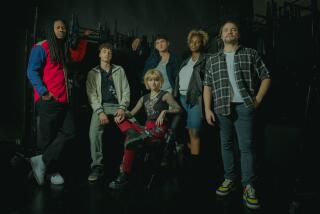A Lively, Silent Gathering at the Mall
- Share via
They told stories, exchanged gossip and even tried out pickup lines, all in silence during a late night visit to a shopping mall.
Hundreds of people, using their language--hand signs and lip reading--chatted away in the strangely quiet scene at The Block at Orange on Friday night. The only sounds: clicking of hands and fingers as arms swayed.
The monthly gathering that began as a small kaffeeklatsch has spontaneously grown into a national phenomenon, drawing up to 600 people from across Southern California and as far away as New York and Washington, D.C.
The event has filled a vacuum caused by what some scholars say is deaf people’s increasing physical isolation from each other. Advances for the deaf, such as mainstreaming in education and at work, e-mail, and closed-captioned television, have worked to unintentionally eliminate the need for face-to-face contact.
“There’s a backlash against all that,” said Karen Nakamura, an anthropology professor who specializes in deaf studies at Macalester College in St. Paul, Minn. “You need something more in life.”
At The Block, the participants--all ages, races and economic standings--instantly shift to “Deaf Standard Time.” It’s a time when deaf people get to dive into their culture and simply forget the clock. Friendships are made, long-lost classmates are found, romances bloom (at least two marriages so far). Conversations last for hours, goodbyes stretch deep into the night.
But the event, popularized in the tightknit deaf community mostly through e-mail and the Internet, is teetering under the weight of its own success.
The crowds have grown large enough to clog the walkways of the shopping center, raising safety concerns among mall and police officials.
For the first time Friday night, mall management hired three interpreters to help with crowd control, hoping to find a way to handle the mushrooming throng.
Perched on a small stage, security guards got the attention of the crowd by shining flashlights on them. And then, through the interpreters, they repeatedly asked the group to spread out through the mall and leave walkways open.
“We welcome them” and want to work out any problems, said Colleen Dunn, the center’s general manager. “Safety issues are our only concern.”
Event organizers said they understand the overcrowding problem and appreciate the mall officials’ sensitivity in trying to thin the crowds.
“We understand it’s hard to move us [because of our hearing problems],” said John Yingst, who teaches a class on deaf culture at Golden West College. “The interpreters tonight helped a lot. People just need to understand the deaf culture is different.”
For example, it’s difficult for deaf people to walk and communicate at the same time because sign language and lip reading must occur face to face. The result at The Block is stationary clumps of people blocking passageways.
Others are trying to determine if a bigger venue--maybe a park, community center or bigger shopping mall--can be found.
That may prove difficult. The Block offers a hip and freeway-friendly location on The City Drive in the center of Orange County.
“I love it here,” said Marcella Chodak, a Corona resident. “It’s a great place to gather.”
The mall’s well-lighted walkways allow for easy signing, and gathering there is free.
The center’s unique characteristics may be why The Block has become the destination of choice for deaf people over the last two years, while similar gatherings in Los Angeles and Riverside remain small.
In fact, the crowd grew so large that the original sponsoring organization, the Southern California Recreation Assn. of the Deaf, withdrew as host of the event. But people just kept coming every second Friday of the month.
Starbucks Coffee is ground zero for the gathering. Some employees have picked up some sign language. They also write names on the sides of coffee cups so deaf customers know when their lattes are ready.
Gladys Berman comes to The Block each month with her 11-year-old daughter, who is deaf.
“The deaf kids are so isolated from each other,” Berman said. “This is a special time. Just look at her.”
Pony-tailed Danielle Berman, a wide smile on her face, chats with a group of other preteens using sign language.
“I love it here because it’s fun,” Danielle said. “It’s great to socialize with the deaf.”
Chris Parent, who grew up in Southern California, was able to tell his former classmates Friday that news of his death was greatly exaggerated. After a series of cross-country moves, Parent, 36, had lost touch with friends. He flew in Friday from Phoenix to attend the gathering at The Block.
“I got the chills and cried a bit,” Parent said. “My friends said, ‘No, it can’t be you. You’re dead.’ ”
Occasionally, some deaf people say they encounter rude remarks from passersby. But for the most part, their presence seems to be a welcomed addition to the mall’s eclectic mix.
“What a nice change of atmosphere,” said Jorge Rivero, an Orange resident. “It shows that all kinds of people can be found here; it doesn’t matter who you are. It makes me want to go out and learn sign language.”
Meanwhile, the crowd talked long into the night, which was no surprise to Ed Kelly, who is deaf and works with the deaf.
“At any party with deaf people, they will be the last to leave--every time.”
More to Read
Sign up for Essential California
The most important California stories and recommendations in your inbox every morning.
You may occasionally receive promotional content from the Los Angeles Times.










